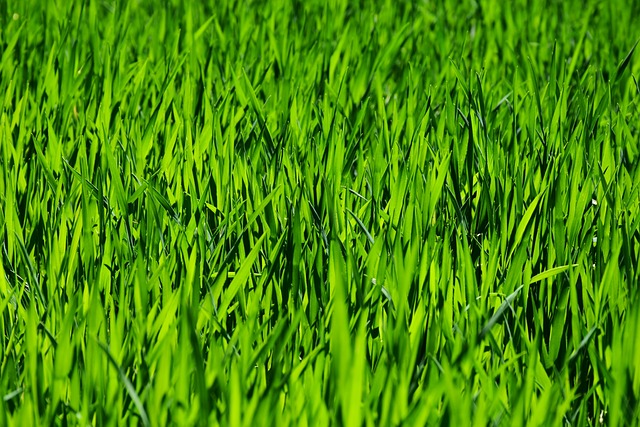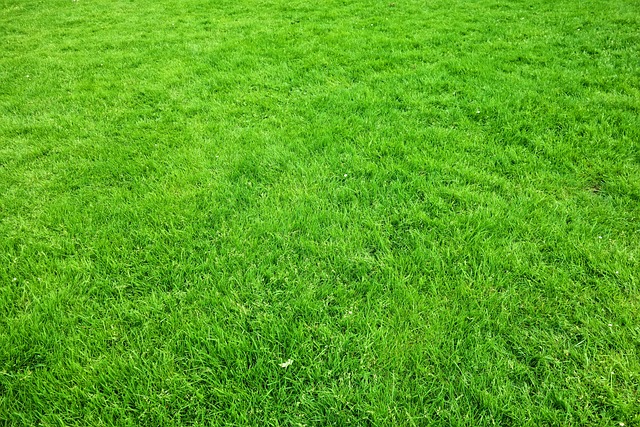Effective lawn mowing is a cornerstone of a robust lawn care and landscaping regimen, essential for maintaining a healthy, aesthetically pleasing yard. The key to successful mowing lies in understanding the specific cutting requirements of different grass types, ensuring that no more than one-third of the grass blade is removed at once to prevent stress and encourage healthy regrowth. Regular mowing with sharp blades not only enhances appearance but also promotes a thicker turf that naturally deters weeds. Additionally, varying mowing patterns can aid in managing soil compaction and growth for a more resilient lawn. Seasonal adjustments in mower height and maintenance, such as sharpening blades and fertilizing according to grass type, are crucial for optimal grass health year-round. Aeration, thatch removal, and overseedng address soil and grass health issues, while a strategic approach to watering and weed control ensures a lush lawn throughout the seasons. Landscape design that complements these practices, incorporating native plants and xeriscaping, further enhances both ecological responsibility and visual appeal. By considering these aspects within your lawn care and landscaping routine, you can achieve a sustainable, beautiful outdoor space that caters to family enjoyment and local ecosystem health.
Embark on a journey to transform your yard into a verdant oasis with our comprehensive guide on lawn care and landscaping. This article delves into the essentials of lawn mowing and maintenance, ensuring your grass thrives throughout every season. From mastering the art of blade sharpening and adjusting mower height to adopting seasonal practices for year-round vitality, learn how these practices contribute to a healthy, beautiful yard. Discover how integrating lawn care with thoughtful landscaping design enhances both aesthetic appeal and functionality, elevating your outdoor space to new heights of serenity and splendor.
- Understanding Lawn Mowing Fundamentals for Optimal Yard Health
- The Art of Sharpening Blades and Adjusting Mower Height for a Healthy Lawn
- Seasonal Maintenance Practices to Keep Your Lawn Vibrant All Year Round
- Integrating Lawn Care and Landscaping Design for Aesthetic Appeal and Functionality
Understanding Lawn Mowing Fundamentals for Optimal Yard Health

A well-maintained lawn is a hallmark of a beautifully landscaped yard, and mastering the art of lawn mowing is central to achieving this goal. Consistent, proper mowing not only enhances the visual appeal but also promotes the overall health of your grass. To cultivate a lush, green yard, it’s crucial to understand the optimal height at which to cut your grass, as different species require varying lengths for robust growth and resilience against pests and diseases. Lawn Care And Landscaping practices dictate that cutting no more than one-third of the grass blade at a time prevents stress and allows for healthy regrowth. The frequency of mowing is also key; regular, scheduled cuts encourage thicker turf which naturally chokes out weeds. Sharp mower blades are essential to ensure clean cuts that reduce the risk of disease and pests. Additionally, mowing patterns can affect soil compaction and grass growth; alternating directions helps maintain soil health and promotes an even turf surface. Implementing these lawn mowing fundamentals as part of your Lawn Care And Landscaping regimen will contribute to a vibrant outdoor space that is both aesthetically pleasing and environmentally resilient. Adhering to the right mowing practices, such as maintaining an ideal mower height for your grass type and keeping your blades sharp, will set the foundation for a thriving landscape year-round.
The Art of Sharpening Blades and Adjusting Mower Height for a Healthy Lawn

Engaging in the art of lawn mowing involves more than just the act of cutting grass; it’s a crucial aspect of lawn care and landscaping that directly affects the health and beauty of your yard. To maintain a lush, vibrant lawn, the blades of your mower should be sharpened regularly. A sharp blade cleanly cuts through grass, creating a more precise cut that allows for better nutrient distribution and promotes strong, healthy growth. This process minimizes the risk of disease and pest infestation by reducing stress on the grass and preventing ragged edges that can serve as entry points for these issues. It’s important to remove the old blade and affix a new one at the correct angle to ensure it cuts cleanly. In addition to sharp blades, adjusting the mower height is another essential element in lawn care and landscaping. The optimal cutting height varies by grass type and season but generally, keeping the grass slightly longer than usual can promote root growth and increase drought resistance. During the growing season, raising the mower deck to its highest setting and gradually lowering it as the grass adapts can foster a thicker turf that naturally deters weeds. Regularly maintaining your mower’s blade sharpness and adjusting the height according to your lawn’s needs will contribute significantly to a healthy, beautiful yard that withstands the elements and remains resilient throughout the year.
Seasonal Maintenance Practices to Keep Your Lawn Vibrant All Year Round

Engaging in seasonal maintenance practices is key to keeping your lawn vibrant and healthy throughout the year. During the early spring, begin by removing any debris that has accumulated over the winter months. Rake away thatch, which can harbor disease and pests, and aerate the soil to promote air and nutrient circulation. Fertilization should be tailored to the specific type of grass you have, ensuring it receives the right balance of nutrients for optimal growth. As temperatures rise, adjust your mowing height to keep the grass long enough to shade the soil surface, reducing weed growth and conserving moisture. Regular mowing throughout the season should never remove more than one-third of the grass blade at a time to encourage root growth.
Summer requires diligent care as heat and sun can stress your lawn. Water deeply but infrequently to promote deep root growth, and be mindful of watering times to avoid evaporation. Weed control is also crucial; apply pre-emergent herbicides in early spring and again in late fall to prevent annual weed seeds from germinating. As autumn approaches, reduce fertilization as grass begins to prepare for dormancy. Fall is the ideal time to overseed thin areas of your lawn to enhance density and vigor. Lastly, into the winter months, keep leaves and other organic matter cleared to prevent matting and disease. Proper end-of-year maintenance will set the stage for a lush, green lawn when spring returns. Lawn care and landscaping practices must be consistent and responsive to seasonal changes to maintain a beautiful yard all year round.
Integrating Lawn Care and Landscaping Design for Aesthetic Appeal and Functionality

Lawn care and landscaping design are synergistic components that, when harmoniously integrated, can elevate the aesthetic appeal and functionality of any yard. A well-manicured lawn serves as a canvas for the broader landscape, with regular mowing, aeration, and fertilization maintaining turf health and vigor. The choice of grass varieties, for instance, can influence the overall look and feel of the landscape while also determining maintenance requirements. Strategic placement of plant beds and hardscapes like paths or retaining walls complements the lawn’s design, creating a cohesive outdoor space that is both visually pleasing and usable. Landscape designers often incorporate native plants and xeriscaping elements to reduce water usage and promote biodiversity, further emphasizing the importance of an ecologically sound approach to lawn care and landscaping. This thoughtful blend of form and function not only enhances the yard’s beauty but also ensures its sustainability over time. By considering the unique characteristics of the property and the needs of the lawn, homeowners can achieve a harmonious outdoor environment that provides numerous benefits for both the family and local ecosystem. Regular maintenance routines, such as mowing at the correct height for the grass type, can further these goals by fostering a healthy turf that withstands foot traffic, resists weeds, and thrives through the seasons. The interplay between meticulous lawn care practices and strategic landscape design thus becomes a cornerstone in creating an outdoor space that is both beautiful and functional.
lawn care and landscaping play a pivotal role in cultivating a lush, verdant yard that not only enhances the aesthetic appeal of your property but also fosters a healthy ecosystem. By mastering the fundamentals of lawn mowing, maintaining sharp mower blades, adjusting mower height appropriately, and adhering to seasonal maintenance schedules, homeowners can ensure their lawns remain vibrant throughout the year. Integrating thoughtful landscaping design principles alongside these practices further elevates the yard’s beauty while promoting functionality. Embracing these practices is key to achieving a picturesque outdoor space that stands out for its natural splendor and meticulous care.
